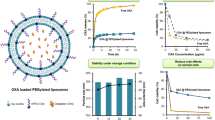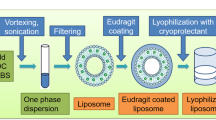Abstract
Taxol is a promising anticancer agent under investigation for therapy of ovarian, breast, colon, and head and neck cancer. One problem associated with the administration of taxol is its low solubility in most pharmaceutically-acceptable solvents; the formulation used clinically contains Cremophor EL® (polyethoxylated castor oil) and ethanol as excipients, which cause serious adverse effects. To eliminate this vehicle and possibly improve the antitumor efficacy of taxol, we have formulated taxol in liposomes of various compositions. Liposome formulations containing taxol and phospholipid in the molar ratio 1:33 were prepared from phosphatidylglycerol (PG) and phosphatidylcholine (PC) (1:9 molar ratio), and were physically and chemically stable for more than 2 months at 4°C, or for 1 month at 20°C. A method of producing taxol-liposomes by lyophilization has been developed, by which large batches can be prepared reproducibly in a ‘pharmaceutically rational’ manner. Taxol-liposomes retained the growth-inhibitory activity of the free drug in vitro against a variety of tumor cell lines. In mice, taxol-liposomes were well-tolerated when given in bolus doses by both iv and ip routes. The Maximum Tolerated Dose (MTD) was >200 mg/kg; it exceeded that of free taxol, which had a MTD of 30 mg/kg by iv or 50 mg/kg by ip administration. Free taxol administered in the Cremophor vehicle was toxic at doses >30 mg/kg, as was the equivalent volume of vehicle without drug. Taxol-liposomes may prove to be useful not only for eliminating the toxic effects attributed to the Cremophor vehicle, but also for providing opportunities to widen the taxol therapeutic index through alterations in route and schedule of administration.
Similar content being viewed by others
References
M. C. Wani, H. L. Taylor, M. E. Wall, P. Coggon and A. T. McPhail. The isolation and structure of taxol, a novel antileukemic and antitumor agent from Taxus brevifolia. J. Am. Chem. Soc. 93:2325–2327 (1971).
E. K. Rowinsky, L. A. Cazenave and R. C. Donehower. Taxol—a Novel Investigational Antimicrotubule Agent. J. Nat. Canc. Inst. 82:1247–1259 (1990).
E. K. Rowinsky, N. Onetto, R. M. Canetta and S. G. Arbuck. Taxol: The first of the taxanes, an important new class of antitumor agents. Seminars Oncol. 6:646–662 (1992).
P. B. Schiff, J. Fant and S. B. Horwitz. Promotion of microtubule assembly in vitro by taxol. Nature 277:665–7 (1979).
M. DeBrabander, G. Geuens, R. Nuydens, R. Willebrods and J. Demay. Taxol induces the assembly of free microtubules in living cells and blocks the organizing capacity of centrosomes and kinetochores. Proc. Natl. Acad. Sci. 78:5608–5612 (1981).
W. P. McGuire, E. K. Rowinsky, N. B. Rosenshein, F. C. Grumbine, D. S. Ettinger, D. K. Armstrong and R. C. Donehower. Taxol: a unique antineoplastic agent with significant activity in advanced ovarian epithelial neoplasms. Ann. Intern. Med. 111:273–279, 1989.
F. A. Holmes, R. S. Walters, R. L. Theriault, A. D. Forman, L. K. Newton, M. N. Raber, A. U. Buzdar, D. K. Frye and G. N. Hortobagyi. Phase II trial of taxol, an active drug in the treatment of metastatic breast cancer. J. Natl. Cancer Inst. 83:1797–1805, 1991.
W. Lorenz, H. J. Riemann and A. Schmal. Histamine release in dogs by Cremophor EL and its derivatives: oxyethylated oleic acid is the most effective constituent. Agents Actions 7:63–67 (1977).
R. B. Weiss, R. C. Donehower, P. H. Wiernik, T. Ohnuma, R. J. Gralla, D. L. Trump, J. R. Baker, D. A. VanEcho, D. D. VonHoff and B. Leyland-Jones. Hypersensitivity reactions from taxol. J. Clin. Oncol. 8:1263–1268 (1990).
W. N. Waugh, L. A. Trissel and V. J. Stella. Stability, compatibility, and plasticizer extraction of taxol (NSC-125973) injection diluted in infusion solutions and stored in various containers. Amer. J. Hosp. Practice 48:1520–1524 (1991).
E. K. Rowinsky, W. P. McGuire, T. Guarnieri, J. S. Fisherman, M. C. Christian and R. C. Donehower. Cardiac Disturbances during the administration of taxol. J. Clin. Oncol. 9:1704–1712 (1991).
C. D. Runowicz, P. H. Wiernik, A. I. Einzig, G. L. Goldberg and S. B. Horwitz. Taxol in ovarian cancer. Cancer 71:1591–1596 (1993).
E. Mayhew and D. Papahadjopoulos. Therapeutic applications of liposomes. In M. J. Ostro (ed.), Liposomes, New York, Marcel Dekker, Inc. 1983, pp. 289–341.
M. C. Popescu, C. E. Swenson and R. S. Ginsberg. Liposome-mediated treatment of viral, bacterial, and protozoal infections. In M. J. Ostro (ed.), Liposomes: From Biophysics to Therapeutics. New York, Marcel Dekker, Inc. 1987, pp. 219–251.
R. M. Fielding. Liposomal drug delivery: Advantages and limitations from a clinical pharmacokinetic and therapeutic perspective. Clin. Pharmacokinet. 21:155–164 (1991).
A. Coune, J. P. Sculies, J. Frahling, P. Stryckmans, C. Brassinne, G. Ghanem, C. Laduron, G. Atassi, J. M. Ruysschaert and J. Hildebrand. I.V. administration of a water insoluble antitumor compound in liposomes. Preliminary report on infusion of liage volumes of liposomes to man. Cancer Treat. Report 67:1031–1033 (1983).
J. P. Sculier, A. Coune, C. B. Rassinne, C. Laduran, G. Atassi, J. M. Ruysschaert and J. Fruhling. Intravenous infusion of high doses of liposomes containing NSC251635, a water-insoluble cytostatic agent. A pilot study with pharmacokinetics data. J. Clin. Oncol. 4:789–797 (1986).
B. Chapuis, C. Helg, M. Jeannet, G. Zulian, P. Huber and P. Gumovski. Anaphylactic reactions to intravenous cyclosporin. New Engl. J. Med. 312:1259 (1985).
S. A. Gruber, S. Venkataram, D. M. Canafax, R. J. Cipolle, L. Bowers, D. Elsberry, M. McGuiggan, P. E. Hynes, J. A. Ritz, F. H. Gould, A. Matas, W. J. M. Hrusheski and Y. E. Rahman. Liposomal formulation eliminates acute toxicity and pump incompatibility of parenteral Cyclosporine. Pharm. Res. 6:601–607 (1989).
R. Perez-Soler, G. Lopez-Berestein, J. Lautersztain, S. AlBaker, K. Francis, D. Macias-Kiger, M. N. Raber and A. R. Khokhar. Phase I clinical and pharmacological study of liposome-entrapped cis-Bis-neodecanoato-trans-R,R-1,2-diaminocyclohexane platinum(II). Cancer Res. 50:4254–4259 (1990).
A. Sharma, W. D. Conway and R. M. Straubinger. Reversedphase high-performance liquid chromatographic determination of taxol in mouse plasma. J. Chromatography (in press).
G. R. Bartlett. Phosphorus assay in column chromatography. J. Biol. Chem. 234:466–468 (1959).
F. Szoka and D. Papahadjopoulos. Comparative properties and methods of preparation of lipid vesicles (liposomes). Ann. Rev. Biophys. Bioeng. 9:467–508 (1980).
R. Fraley, R. M. Straubinger, G. Rule, L. Springer, and D. Papahadjopoulos. Liposome-mediated delivery of DNA to cells: enhanced efficiency of delivery by changes in lipid composition and incubation conditions. Biochemistry, 20:6978–6987 (1981).
T. D. Heath, N. G. Lopez and D. Papahadjopoulos. Effects of liposome size and charge on liposome-mediated delivery of methotrexate-γ-aspartate to cells in vitro. Biochim. Biophys. Acta, 820:74–86 (1985).
A. Sharma, N. L. Straubinger and R. M. Straubinger. Modulation of Human Ovarian Tumor Cell Sensitivity to N-(Phosphonacetyl)-L-Aspartate (PALA) by Liposome Drug Carriers. Pharm. Res., 10:1434–1441 (1993).
T. H. Corbett, D. P. Griswold, B. J. Roberts, J. Peckham and F. M. Schabel. A mouse colon-tumor model for experimental therapy. Cancer Chemother. Reports 5:169–186 (1975).
K. Crickard, M. J. Niedbala, U. Crickard, M. Yoonessi, A. A. Sandberg, K. Okuyama, R. J. Bernacki and S. K. Satchidanand. Characterization of human ovarian and endometrial carcinoma cell lines established on extracellular matrix. Gyne. Oncol. 32:163–173 (1989).
F. C. Szoka, D. Milholland and M. Barza. Effect of lipid composition and liposome size on toxicity and in vitro fungicidal activity of liposome-intercalated amphotericin B. Antimicrob. Agents Chemother. 31:421–429, (1987).
T. D. Heath and C. S. Brown. Liposome dependent delivery of N-(phosphonacetyl)-L-aspartic acid to cells in vitro. J. Liposome Res. 1:303–317, (1989–90).
R. Straubinger, A. Sharma, M. Murray and E. Mayhew. Novel taxol formulations: taxol-containing liposomes. J. Natl. Cancer Inst. monographs, 15:69–78 (1993).
W. C. Rose, Taxol: a review of its preclinical in vivo antitumor activity. Anti-Cancer Drugs 3:311–321 (1992).
H. M. Deutsch, J. A. Glinski, M. Hernandez, R. D. Haugwitz, V. L. Narayanan, M. Suffness and L. H. Zalkow. Synthesis of congeners and prodrugs. 3. water-soluble prodrugs of taxol with potent antitumor activity. J. Med. Chem. 32:788–792 (1989).
C. S. Swindell, N. E. Krauss, S. B. Horwitz and I. Ringel. Biologically active taxol analogues with deleted A-ring side chain substituents and variable C-2′ configurations. J. Med. Chem. 34:1176–1184 (1991).
M-C. Bissery, D. Guenard, F. Gueritte-Voegelein and F. Lavelle. Experimental antitumor activity of taxotere (RP 56976, NSC 628503), a taxol analogue. Cancer Res. 51:4845–4852 (1991).
B. D. Tarr, T. G. Sambandan and S. H. Yalkowsky. A new parenteral emulsion for the administration of taxol. Pharm. Res. 4:162–165 (1987).
A. Sharma, E. Mayhew and R. M. Straubinger. Antitumor effect of taxol-containing liposomes in a taxol-resistant murine tumor model. Cancer Res. 53:5877–5881 (1993).
Author information
Authors and Affiliations
Rights and permissions
About this article
Cite this article
Sharma, A., Straubinger, R.M. Novel Taxol Formulations: Preparation and Characterization of Taxol-Containing Liposomes. Pharm Res 11, 889–896 (1994). https://doi.org/10.1023/A:1018994111594
Issue Date:
DOI: https://doi.org/10.1023/A:1018994111594




